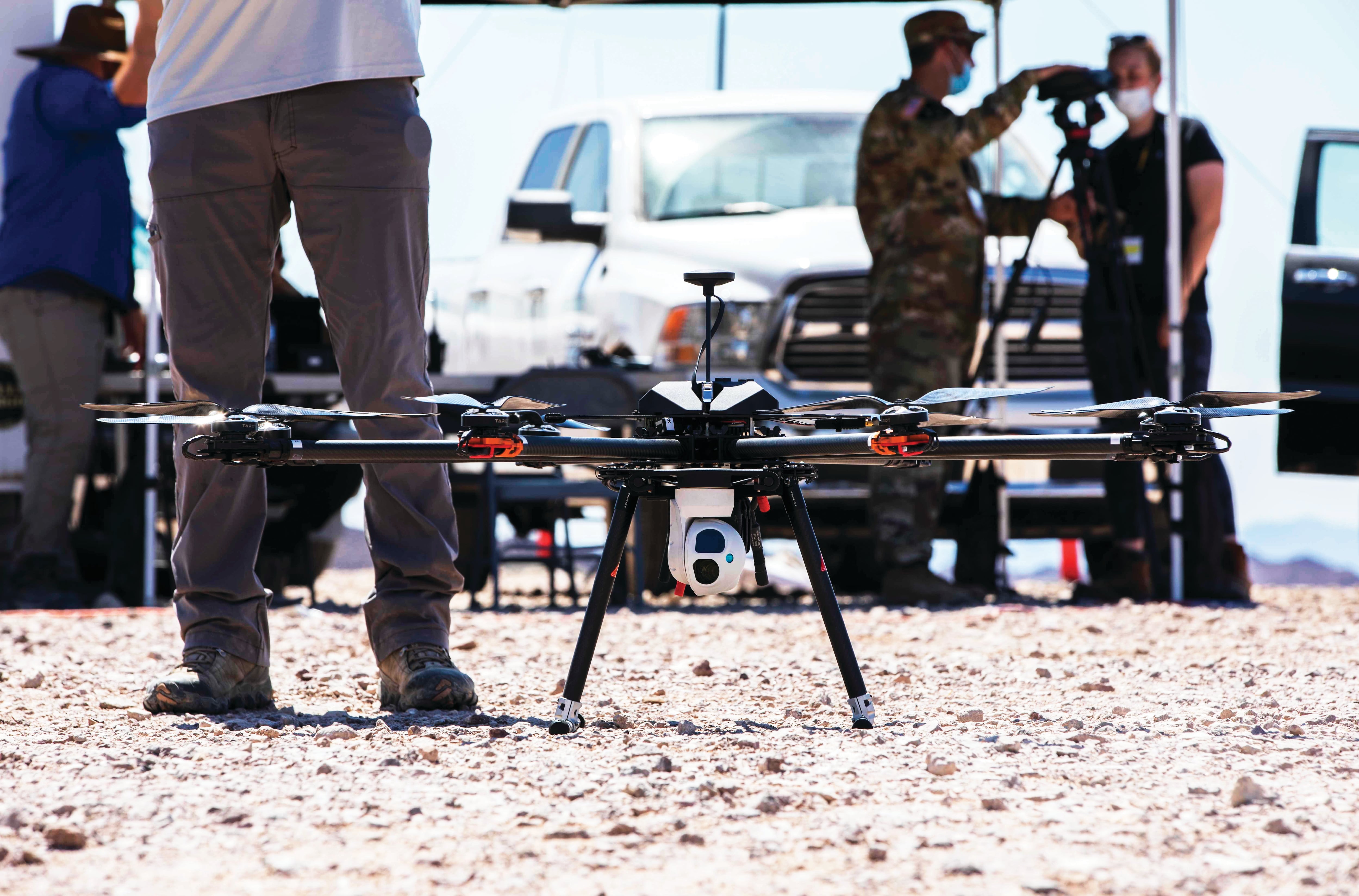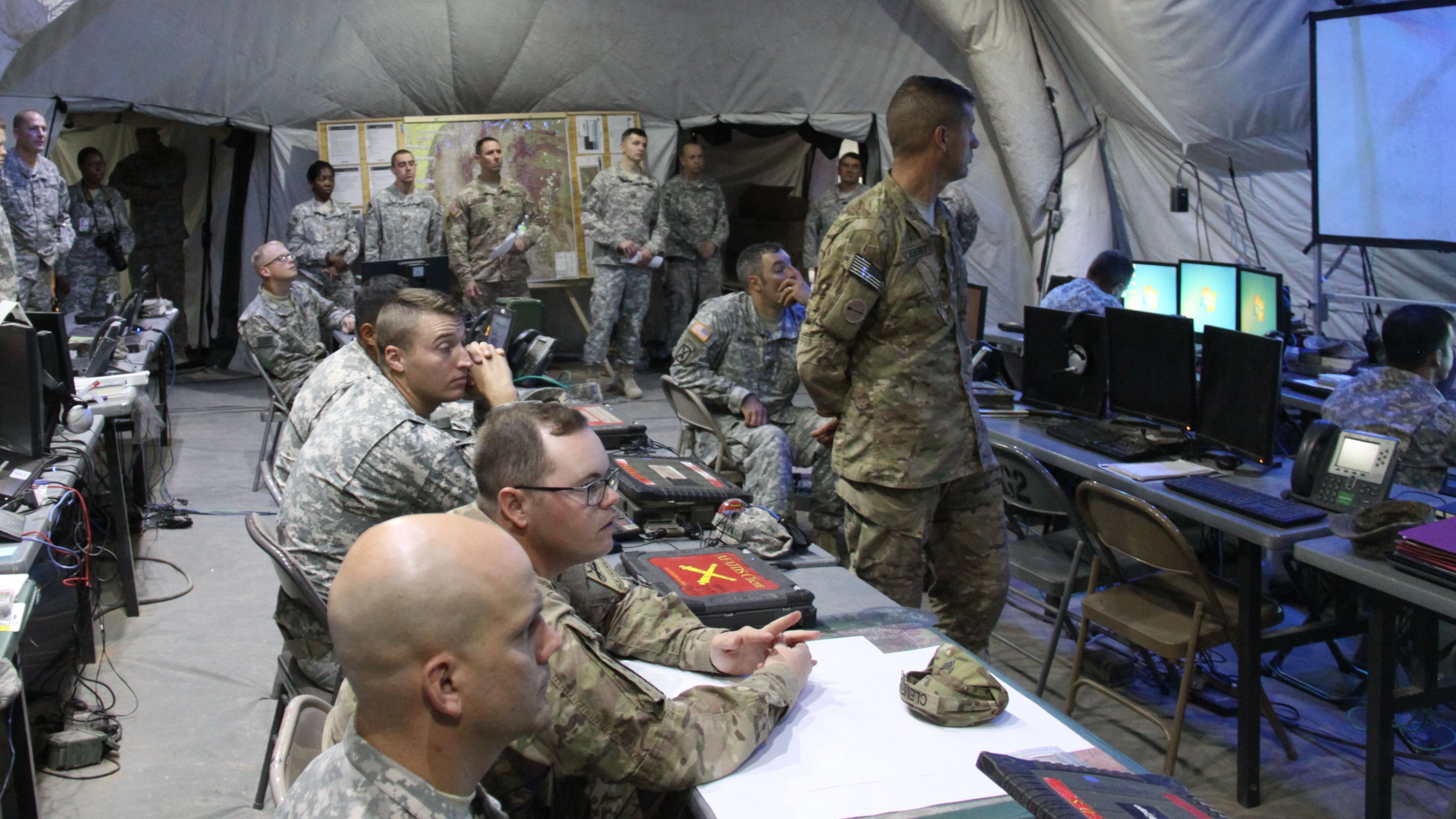UPDATE — This story has been updated to reflect the correct number of images taken to train AI systems.
YUMA PROVING GROUND, Ariz. — During the U.S. Army’s high-profile test of emerging technology in the Arizona desert last month, service leaders packed explosives into a prototype of the Extended Range Cannon as part of a bold experiment.
The cannon had the ability to fire beyond 70 kilometers, and the XM1113 projectile had been customized with a precision guidance kit (not the next long-range precision guidance kit that will be integrated later).
“It didn’t go off every time,” Brig. Gen. John Rafferty, who oversees long-range precision fires modernization, said of the weapon during an Oct. 2 interview with Defense News. “It was kind of disappointing when there was a hole in the ground right next to the target because it didn’t explode.”
The XM1113 incident matched what many service leaders experienced at Project Convergence as new concepts and modernization efforts were put to the test. Sometimes, Army officials were thrilled with the progress of new technologies. Other times, they saw room for improvement.
“This is a major step forward in transforming the United States Army for the next 40 years,” Army Chief of Staff Gen. James McConville said while attending Project Convergence at Yuma Proving Ground.
“This may not be the most important thing Army Futures Command is working on,” added Gen. Mike Murray, the head of the command. But “this may be the most important thing the Army is doing today,” outside of global ongoing operations.
The service is shifting its focus from counterinsurgency operations in the Middle East to an era of great power competition — one where the United States must be prepared to operate against advanced adversaries in high-end conflict across air, land, sea, space and cyber domains.
Army leaders hope Project Convergence shows the service is more willing to abandon the customary hand-wringing over whether technology is completely mature, and instead jump into the fray to try and even fail publicly.
“Every one of these weapons systems, as they get anywhere close to a determination by Army leadership … we’re putting it in Convergence,” Army Secretary Ryan McCarthy told reporters before the event. “It’s a much more effective means for operational tests.”
Perfection vs. progress
Project Convergence was meant to be hard, Army leaders said, to challenge in the harshest of environments the systems and concepts that would be needed to against sophisticated adversaries like Russia and China.
The Army picked Yuma Proving Ground for the new experimental exercise because of its “harsh conditions," large operating area and “brutal” temperatures that reached 120 degrees, the exercise’s commander, Brig. Gen. Ross Coffman, said Sept. 23 on the ground at Yuma. “We knew that if we could accomplish our mission here, we can do it almost anywhere on Earth.”

It was so hot in the Arizona desert that aircraft tires blew up on the runway.
While the effort met and, in some cases, greatly exceeded expectations, it was wholly imperfect.
The service flew a group of reporters to Yuma on the last day to witness firsthand how its efforts were panning out. In a small warehouse full of military leadership, reporters, foreign military counterparts, civilian engineers and legislative staffers, the Army put its tech to the test.
At the front of the room were eight large television screens: The top four showed livestreams of the action occurring on the range — mortar fires, drones flying overhead and the targets set to be destroyed.
Yet the real action was taking place on the four bottom screens, where observers could see the Tactical Assault Kit — a software system giving operators a common picture of what was happening on the range — and other advanced software applications. And below those screens were 10 Army operators controlling all of the action from behind their monitors.
“I was focused on those 10 people up front that were simulating a tactical operation and a little less so on the screens,” McCarthy told reporters the day after the exercise. “The only screens that I really cared about were the lower ones that showed how they were moving the pieces from the battlefield.”
In other words, Project Convergence was not about the boom. It was not about hitting the targets.
Which is good. Because not all of them did.
On that day, the Army missed two targets during live-fire demonstrations. In the first miss, a modified Gray Eagle UAV used another drone as a munitions mule. The primary Gray Eagle identified the threat, ordering the other drone to drop a glide munition on the target. The first Gray Eagle was supposed to guide that munition to the target over the Army’s tactical network — however, a lost network connection led to a miss, Murray confirmed to Defense News.
In the other miss, an XM1113 projectile failed to explode on its target after being fired from the first prototype of the Army’s Extended Range Cannon, which has the capability to fire beyond 70 kilometers.
“This was the first time we had the XM1113 firing targets with high explosives inside of it, instead of inert, with a currently fielded precision guidance kit, not the [next] long-range precision guidance kit,” Rafferty said. “It didn’t work every time. It was accurate, but it didn’t go off every time.”
“The bullets flying through the air and exploding is interesting,” Coffman said. “But that’s not what’s compelling about Project Convergence. It’s everything that happens before the lanyard is pulled, the trigger is pulled. We didn’t come out here for a precision fires exercise. What we came here to do is increase the speed of information between sensing the target and passing that information to the effector.”
By creating a complex network of systems, the Army was able to dramatically shorten its kill chain. And the service moved the architecture from PowerPoint to a living and breathing capability in less than eight months.
Science and technology efforts that were just “two months ago an idea in a lab some place in an air-conditioned building” were worked into the exercise, Murray said.
“I can’t emphasize enough that yesterday exceeded any expectation that I could have had. It was an experiment. It was an experiment at scale for a combined arms operations, and the fact that they compressed the timespan … was incredible,” McCarthy said.
Networks aren’t built in a day
Over the course of the effort, the Army was able to shorten its sensor-to-shooter timeline from 20 minutes to 20 seconds by using emerging artificial intelligence algorithms, experimental tactical networks and space-based sensors. This introduced a new pipeline that takes sensor data, transforms it into targeting data and delivers it to the best possible shooter at blazing speeds.
“Taking information from space-based sensors and passing into ground- and air-based effectors seems really simple and happens super fast, but it was very complex and took us weeks of hard coding in order to get it done,” Coffman said.
Added Murray: “It’s all about the ability to pass data, and if you can’t do that, a long-range cannon becomes interesting, but not really relevant."
During the effort, “we had all kinds of problems. That’s why we were rewriting code and fixing stuff constantly,” he continued. “But you know? It worked.

The network “was a plus and minus,” he explained. It was the backbone of everything the Army was doing at Project Convergence, but “like everything else we brought, what we had, it wasn’t designed for this,” he added.
The network used during the event is being designed for a tactical brigade, and not to operate in the context of Project Convergence in a constrained bandwidth environment, he noted. “The network worked. It just took a tremendous amount of work to get it to work."
For example, the Army had a hard time getting the network to connect from ground assets to air assets, according to Murray, while ground-to-ground and air-to-air connectivity performed well.
The connectivity between ground and air was established — for the first time ever — through a mesh network of unmanned aircraft called Air-Launched Effects that were intended to serve as repeaters to extend connectivity beyond line of sight.
Some of the problems had to do with the conditions. “There were lots of days we couldn’t fly because of crosswinds,” Murray said. “I think just continuing to refine [the mesh network] and increasing — really not necessarily the range but the throughput capacity — is probably where we need to go.”
There were also tests that surpassed expectations. With some systems, it was expected that “swivel chair” methods would be needed to manually input information from one system into another. “We were able to actually automate machine to machine, which we weren’t expecting to be able to do,” Murray said.
Project Convergence was easily the Army’s — and perhaps the entire military’s — largest test of emerging AI capabilities to date. AI algorithms were used to speed up the sensor-to-shooter chain at every point. But perhaps the biggest star of the event was FIRES Synchronization to Optimize Responses in Multi-Domain Operations, or FIRESTORM.
“What is FIRESTORM? Simply put, it’s a computer brain that recommends the best shooter, updates the common operating picture with the current enemy situation and friendly situation, [and] admissions the effectors that we want to [use to] eradicate the enemy on the battlefield,” Coffman said.
Observers at Project Convergence were able to see FIRESTORM’s recommendation pop-ups in real time — often in the blink of an eye — allowing operators to rapidly review and approve the algorithm’s recommendations.
But the AI systems at play are still in development, and Army officials acknowledged they remain brittle.
While prepping for Project Convergence, the Army used more than 3.5 million images of opposing and friendly forces' tanks and vehicles to build a database of enough images in different contexts to train the algorithms needed for the exercise. “Every image you get to train an algorithm just makes that algorithm better,” Murray said.
“Artificial intelligence is no different than a human being," added McCarthy. "It needs a number of repetitions to be perfect. The difference is they’ll be faster and better because it’s a machine. But you still have to have hundreds if not thousands of these repetitions to make it perfect.
"And you might have seen the fourth rep. Come back when there’s 400.”
Cultural shift
Project Convergence pointed the Army in the direction it must go if it wants to shape a force for future conflict, but the effort also pushed the service toward a major cultural change.
“It’s OK to fail,” Murray said. "I’ve done some touchpoints with soldiers, and soldiers aren’t used to failing and it actually drives them crazy when you put a piece of immature technology in their hands that doesn’t work exactly like they expect it to work.
“That’s part of the culture change: It’s OK,” he said. “You’re learning, growing and making better decisions, investments, as you continue to mature this technology. I think this is absolutely the way forward.”
Jen Judson is an award-winning journalist covering land warfare for Defense News. She has also worked for Politico and Inside Defense. She holds a Master of Science degree in journalism from Boston University and a Bachelor of Arts degree from Kenyon College.
Nathan Strout covers space, unmanned and intelligence systems for C4ISRNET.








